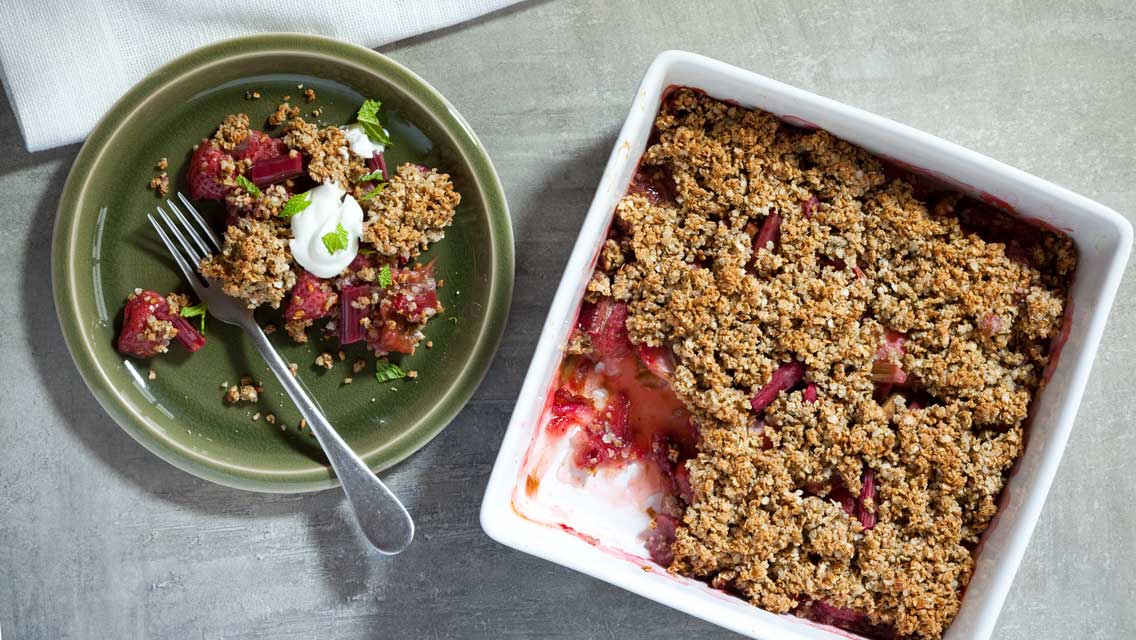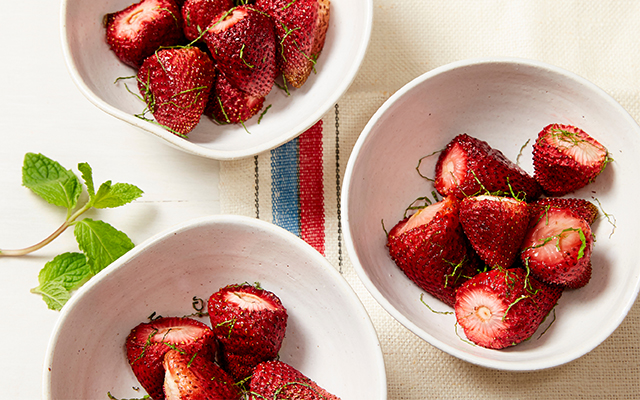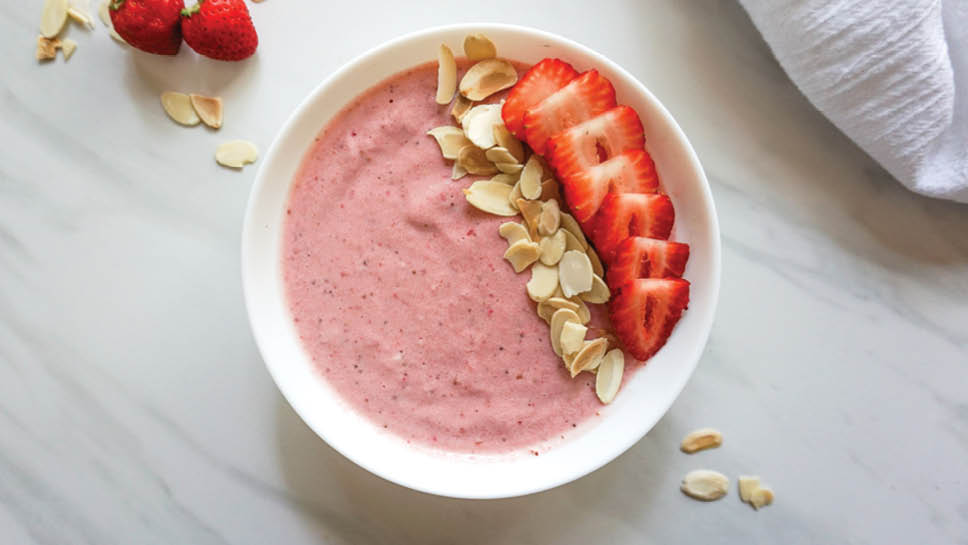I have seen sun-dappled strawberries grilled, roasted, marinated, macerated, puréed, “salsa-fied,” baked in a pie, put up in a jam, dipped in chocolate and frozen in ice cream. I could go on about cooking methodology ad nauseam. But what is more sublime than a perfectly ripe strawberry, plucked from the vine and popped in the mouth?
Aah … the guilty pleasure of procrastination as you forget for a moment about filling your basket. The extravagant smell of the berry in your mouth as you bite down on it for the first time. The texture – its surface seeded, yet smooth, its interior firm, yet yielding. And the taste: bliss.
To my mind, great cooking is first and foremost about honesty, authenticity and sourcing the very best ingredients. The cook’s job is to manipulate an ingredient in the most unobtrusive way possible, improving it, highlighting the best of its characteristics, minimizing any culinary deficiencies. Strawberries afford us the best of these possibilities; they invite us to get out of their way.
Accessible Pleasure
Very few of us will ever pull a 30-pound striped bass out of the surf, and then throw it on a fire roaring in the lee of a sand dune. Fewer still will spend dawn’s early hours in the hills of Alba, rooting out October’s first truffle. But all of us can grow a strawberry, or drive a short distance and pick them, or pull over to the side of a country road and buy a pint from a freckled youngster who is minding the family farm stand. Strawberries aren’t hard to come by. But that doesn’t make them any less special.
Strawberries have been gathered in the wild in the Americas and Eurasia for tens of thousands of years. In fact, the strawberry – a vinous member of the rose family – was a primary food source for our hunting and gathering ancestors. Eventually we learned to dry them, store them and preserve them. Thousands of years ago in America, early indigenous peoples cultivated them, resulting in a large plump species native to our hemisphere.
In Europe, the Romans were the first to farm their berries, using them to cure a variety of gastric problems, and also as a diuretic. European strawberries were smaller and more intense in flavor, commonly referred to today as frais de bois. It wasn’t until the 15th century that Europeans began cultivating these species in earnest. As part of the cultivation process, straw was used to keep the beds elevated and free of weeds. And thus, the modern berry had a catchy new moniker: “straw-berry.”
Eventually a young French engineer named Frezier was sent to Chile to review Spanish military installations. There he encountered a large, plump, fragrant red strawberry, which he brought back to France. In 1821, with the Frezier strain as a starting point, an English market gardener named Michael Keens produced a seedling remarkable for its size and flavor. The fragaria ananassa was born. This garden-variety berry – a hybrid between the Chilean variety and the wild North American species – is now the most common one grown, both here in the United States and abroad. Virtually all modern varieties are derived from it.
Berry Well
From a health and wellness standpoint, strawberries are terrific. They are very high in vitamin C, which is one of those essential water-soluble vitamins your body can’t make or store. For optimum health and immunity, you need vitamin C every day, so it’s important that you take in – I’m talkin’ eating here – your daily requirements. A cup of strawberries contains more vitamin C than an orange, plus a healthy dose of folic acid, soluble fiber and beta-carotene. Both vitamin C and vitamin A (which your body manufactures from beta-carotene) are members of a group of nutrients called antioxidants. These free-radical neutralizers are known for both their cancer-fighting and anti-aging properties, and science is daily expanding our understanding of how critical they are in maintaining our bodies’ health.
Both for health and flavor reasons, I buy fresh fruit from local organic farmers whenever possible. Because conventional strawberries are some of the most heavily pesticide-sprayed crops around (and among the hardest to rid of the residue) organic is an especially good choice in this case. I also like local, freshly picked farm produce because it has a greater chance of containing more vitamins and nutrients. This is a result of local produce generally having better soil content, sunlight exposure and moisture availability than its supermarket counterparts, which have to be trucked across the country from massive commercial farms.
More important still – in fact, perhaps the most crucial factor in the healthfulness and appeal of any fruit or vegetables – is maturity at harvest. Major chemical changes take place as plants mature, yield fruit, then ripen and decline. There is a window, just before decline, in which the nutrient content and flavor of produce is at its absolute prime. For this reason it is best to consume fruits as close to harvest time as possible (more easily done when your berries are from down the road than from across the country). And what, after all, could taste better, or be better for you, than a perfectly ripe, freshly picked strawberry?
Here are some tips for making the most of your haul:
- Pick firm, plump, red berries with full green leaves and caps intact.
- Remember that cold deadens the flavors and texture of most soft fruits. Leave the berries at room temperature for as long as possible without courting spoilage.
- Do not wash berries until just before using.
- If you must refrigerate, store for only two to three days on a paper towel in a moisture-proof container.
- Don’t freeze whole berries (they disintegrate when thawed).
- Like vegetables, fruits get softer and juicier when cooked, but they also tend to lose a lot of their integrity and color. To hold color in cooked berries, be sure to add acid-rich foods (like lemon juice or rhubarb) that help retain the berries’ pigments.
- Sugar is an acid that draws water out of fruits. Only sprinkle sugar on your fruit right before eating or cooking. Exceptions are when making jam or ice-cream.
Good Eating
Try some of these wonderfully simple preparations:
- Toss with a sweet vinegar, cucumbers, red onion, feta, extra virgin olive oil and lots of basil for a marvelous salad.
- Combine 1/2 cup balsamic vinegar and 6 ounces white chocolate in a double boiler over slow heat. When melted, pour fondue into warmed ramekins and dip strawberries.
- Roast in a 400-degree oven until shrunken, caramelized, but still soft and use in your favorite muffin or scone recipes.
- Poach berries in a Muscat or Sauternes with star anise and ginger. Chill and serve.
- Toss 1 quart cleaned berries in 1/2 cup brown sugar, 1 tbs. ground pepper and 1/4 cup balsamic vinegar. Marinate for 2 hours refrigerated, tossing each half hour. Drain and serve.
Macerated Berries with Mint and Red Wine
Thomas Hyall wrote in his cookbook of 1593: “Strawberries are much eaten at all men’s tables with wine and sugar.” Cream is the traditional English accompaniment for berries. Elsewhere in Europe, crème fraiche or sour cream is preferred. But in Italy, red wine and sugar are used instead. I developed this recipe after years of enjoying wild berries served in this fashion at Trattoria Sostanza in Florence.
- 2 quarts freshly picked strawberries, hulled and washed
- 1 bottle (750 ml) dry Italian red wine (a good Chianti works well)
- 2/3 cup sugar, more or less to taste
- Zest of 1 orange, taken off the fruit with a “strip zester” (strips of zest should be about 1/16 of an inch wide)
- Juice of 1 orange
- 1 piece cinnamon
- 4 cloves
- 1 cup loosely packed fresh mint leaves.
Directions
- Place the wine in a saucepan along with the juice, cinnamon, cloves and sugar. Bring to a simmer, turn off the heat and let rest for 1 hour to cool.
- Put the berries and zest in a large bowl. Add the wine and refrigerate for 4 hours.
- Add mint leaves to berry mixture, toss lightly and divide into large wine or dessert glasses. Spoon remaining liquid over desserts and serve.





This Post Has 0 Comments